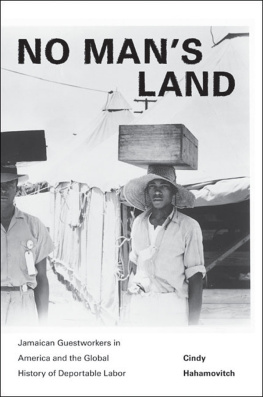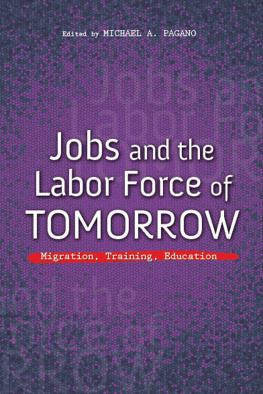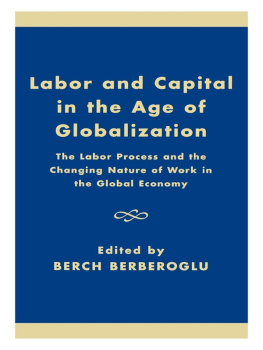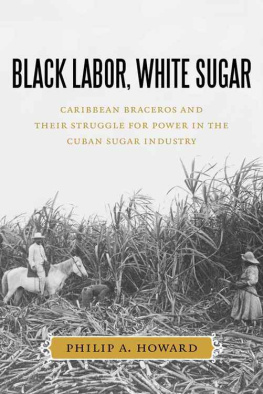First published 1988 by Westview Press
Published 2018 by Routledge
52 Vanderbilt Avenue, New York, NY 10017
2 Park Square, Milton Park, Abingdon, Oxon OX14 4RN
Routledge is an imprint of the Taylor & Francis Group, an informa business
Copyright 1988 by Taylor & Francis
All rights reserved. No part of this book may be reprinted or reproduced or utilised in any form or by any electronic, mechanical, or other means, now known or hereafter invented, including photocopying and recording, or in any information storage or retrieval system, without permission in writing from the publishers.
Notice:
Product or corporate names may be trademarks or registered trademarks, and are used only for identification and explanation without intent to infringe.
Library of Congress Cataloging-in-Publication Data
Petras, Elizabeth McLean.
Jamaican labor migration: white capital and black labor, 18501930 /
by Elizabeth McLean Petras.
p. cm.--(Westview special studies on Latin America and the
Caribbean)
Bibliography: p.
Includes index.
ISBN 0-8133-7456-1
1. Alien labor, Jamaican--Panama--Canal Zone--History. 2. Alien
labor, Jamaican--Cuba--History. 3. Alien labor, Jamaican--History.
4. Jamaica--Emigration and immigration--History. 5. Labor and
laboring classes--Jamaica--History. I. Title. II. Series.
HD8178.P47 1988
331.627292072875--dc19
87-20139
CIP
ISBN 13: 978-0-367-01421-6 (hbk)
Historical Background to the Formation of a Migratory Labor Reserve in the Nineteenth Century
Introduction
Tropical islands in the Caribbean were attractive investment sites for the growing capital being accumulated from commerce and industry in seventeenth- and eighteenth-century England. The British perceived the West Indies as important for their agro-industrial potential as sugar producers rather than for development as settlement colonies. Loaning money on Caribbean mortgages constituted an important form of investment for British capitalists. London, Liverpool, and Glasgow merchants in particular made heavy advances to the planters (Ragatz 1928:43). Ecologically, the region was superb for the enterprise. Initial requirements for setting up operations were generally minimal, and return profits flowed rapidly and abundantly. However, the wealth of the West Indies had been an artificial creation, resting on a monopoly of supplying the home and British-American mainland markets with Caribbean products, enjoyed by the few residents of a small number of islands. The favored individuals had never fully developed their holdings, the quantity of produce grown had failed to keep pace with the demand, and high prices with exorbitant profits had resulted (Ragatz 1928: vii).
The demise of the sugar industry was as precipitous as its rise. By the middle of the nineteenth century, sugar had been displaced within the British economy, relegated to the economic status of a poor relative in the Caribbean. The collapse of the sugar economy had repercussions within Jamaica and throughout the British West Indies, intensifying a number of interrelated developments. During this era, labor in the industry was freed from the coercive bondage of slavery. Internal production structures began to decay, and British credits and investments dwindled as England struggled to deflect the loss of its competitive strength in the world market by transferring capital to other sites.
Just as sugar production had expanded on the basis of coerced importation of men and women to satisfy its labor demands, so did its decline set loose these once-enslaved laborers. No longer bound to an industry whose continued existence was problematic, new freemen were confronted with several alternatives: remain dependent on the floundering plantations as landless, cheap-wage laborers; abandon the estates and set up cultivation as small freeholders? or leave the agricultural sector and perhaps the island in search of paid employment elsewhere.
Many households combined more than one form of these productive activities. No single option proved economically feasible, however, and gradually a vast reservoir of surplus labor began to form. The subsequent incorporation of reserve labor from Jamaica into a global labor market and the crystallization of labor export as a specialization of the Jamaican social formation within the world economy ensued.
The first five movements of labor recruitment and migration out of Jamaica stretched over nearly a century. Cross-national movement of Jamaican laborers coalesced between 1850 and 1881, reached a peak by 19111914, and began to ebb and return by 19211929. The initial flow consisted of men recruited for the construction of the Panama railway, and the second involved the procurement of laborers by a French company attempting to construct a canal across the Isthmus of Panama. This was followed by the importation of Jamaicans, along with large numbers of West Indians from other islands, for the construction of the Panama Canal by the U.S. Canal Commission. The final movement was composed of workers traveling to Cuba, where they were employed largely by the U.S. firms that dominated the Cuban sugar industry, or as female domestics, seamstresses, or service workers. There was also significant recruitment of Jamicans by U.S. agro-industrial firms opening up and operating plantation lands in Costa Rica, a region where they had been recruited earlier for railroad construction.
Most of the desperation that motivated individuals to leave was bound to the economic shiftsregional and globalof the period. Legislation and trade restrictions proposed by various states as they struggled to secure optimal conditions for the advancement of their own enterprises, the fluctuations of global trade and production, and the economic trends that they engendered all contributed to the formation of a peripatetic labor force in the Caribbean.
Jamaica: The Richest Jewel in the British Crown
The great age of the Caribbean was the seventeenth and eighteenth century when sugar occupied in the international market the place later usurped by cotton and taken today by oil and steel. (Williams 19712:7)
The Origins of the Sugar Industry
During the latter half of the seventeenth century, Europeans began to claim Jamaican lands for plantation sites. Sugar quickly emerged as the only low-investment, high-profit crop. Harsh competitive conditions followed the domination of sugar over a variety of other crops, and the elimination of many small growers of cane ensued.
Jamaicas specialization as a sugar producer was fully established in the worldwide economic network that British capital had created by the mid-eighteenth century. More Jamaican-produced sugar was being exported by 1750 than all the English-dominated colonies together had produced fifty years earlier (Dunn 1972:204). Until the end of the century, British sugar magnates reaped tremendous wealth from this Jamaican-grown crop, and the revenues being accumulated were reinvested in the burgeoning mills of Bristol, Manchester, and Liverpool. These industries expanded in turn through the sale of their manufactured goodswoolen and cotton products, copper, and brassback to the islands.






